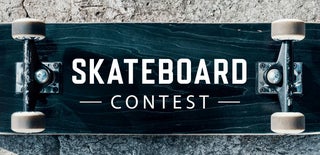Introduction: Vintage Style Skateboard // Free Template
Inspiration struck when I came across a wall of skateboards during a trip to a local antique store. After spending a ridiculous amount of time ooing and aweing at all the different styles, shapes, and colors of the boards, I knew that's what I wanted to make. My goal was to replicate the look and feel of the boards as closely as possible. I picked all the different parts and features of the boards that I liked and combined them all together to create my board. After combining the vintage style of the board I created with modern hardware, I came up with a unique one-of-a-kind board that I love and hope you will love too.
Make sure to download a free copy of the template I designed, link in the video description.
Supplies
Red Oak (3.5 in wide by 3/4 in thick)
Wood Glue
Super 77 Spray Adhesive
Krylon Gloss Banner Red Spray Paint
Krylon Flat White Spray Paint
Vinyl Mask (Oracal 813)
Clear Transfer Tape
Painter's Tape
Newspaper
Skateboard Trucks and Hardware
Step 1: Measure and Cut
I started out with a piece of red oak that was 3.5 inches wide and 3/4 inches thick. I measured out to 24 inches long and cut two pieces on the miter saw. One handy tip is to apply painter's tape to the underside of the cut to reduce tear out from the saw.
Step 2: Glue the Pieces Together
With the pieces cut, I glued them up to form my board blank. Apply enough pressure with the clamps to close any gaps but not so much that the boards start to bow. I used a straight edge to make sure they we’re laying flat.
To attach the template I designed, I used a very light coat super 77 spray adhesive
Step 3: Cutting and Shaping
Using the band saw I cut the shape out. I only had a 3/4 inch resaw blade on hand so the cuts were rougher than they needed to be. A thinner blade would have given me a tighter cutting radius. I made sure to stay away from the line. Using the belt and disk sander I could sand right to the line and get it perfect.
Step 4: Drilling
I located the trucks and marked where the holes needed to be drilled. I used an 11/16 inch drill bit to drill the holes to mount the trucks.
With the final shape and mounting hole drilling done I could take the template off.
In order to get the screws to sit flush with the top and not get in the way when riding I used a counter sink bit to recess the screw heads below the surface.
Step 5: Final Sanding
I gave the board its final sanding in preparation for paint and made sure to remove the dust from the surface. I also broke the sharp edges along the board by rounding them over slightly with a piece of 220 grit sandpaper.
Step 6: Painting
With the board sanded and completely free from dust I could move on to painting it. I used "Krylon Gloss Banner Red" spray paint. I applied 4 light coats in total waiting 15 minutes in between coats for drying
One thing to note is that I didn’t seal the wood before applying color because I wanted an open pore finish to match the vintage boards as closely as possible.
Step 7: Masking for Lettering
I used a vinyl cutter to cut out the lettering while the paint was drying. You don’t need a vinyl cutter to do this but it does make the process faster. I then weeded out the letters, leaving only the outline. Once the stencil was weeded I applied a clear transfer tape over the entire stencil, this keeps everything in place when removing the vinyl from the paper backing. I lined up the stencil to the center of the board as best as I could. Once the stencil was in place I removed the transfer tape.
I’m using an ink brayer to really press the stencil into the surface to try and minimize the chance of paint bleeding underneath.
I used a combination of painters tape and newspaper to mask off everything I didn’t want to end up white. I used newspaper to save on painters tape
Step 8: Painting the Lettering
I used "Krylon Flat White" spray paint. I applied 4 light coats in total waiting 15 minutes in between coats for drying. After the paint was completely dry I could peel off the vinyl stencil. With an open pore finish like this the chance of paint bleed is really high but luckily it was pretty minimal. I actually lost the inner part of the last “e” on the stencil but I was able to scratch off the white to reveal the red underneath
Step 9: Final Assembly
With the paint done it was finally time to assemble the board. I positioned the trucks and bolted them down to the board
This thing came out great and I couldn’t be happier. One thing to note is I didn’t apply grip tape or a clear coat to the board, and that’s because I was trying to match the board as closely to the boards I saw at the antique store. None of them had grip tape so I didn’t put any on mine. I actually really like the idea of the paint getting chipped and cracked over time making the board look used and abused.
Step 10: Have Fun
The only thing left to do now is to ride it and have fun!

Runner Up in the
Skateboard Contest











